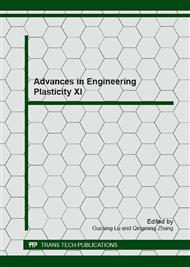p.227
p.231
p.235
p.239
p.243
p.247
p.250
p.254
p.263
An Upsetting - Ironing Type Tribo-Meter for Evaluating Tribological Performance of Lubrication Coatings for Cold Forging
Abstract:
In recent years, many attempts are being made to develop new lubrication coatings for cold forging. In general, an alternative coating is designed based on the results of the evaluation methods that simulate the frictional condition of cold forging. Various evaluation methods have been proposed and used to design an alternative coating according to the processing purpose. However a lot of parts are manufactured by the multistage forging machine such as parts forming machine, complex shape being produced recently by combined processing. A lubrication coating in such an environment is exposed to repeatedly in a variety of processing modes, and received serious damage. At present the performance of an alternative coating isn’t enough to satisfy needs of market in such a multistep forging. Development of lubricant that can satisfy such demands needs a new evaluation method. This comes the purpose of this study. An newly devised tribometer consists of an ironing process after upsetting process. We designed this test method by using finite element(FE) analysis. In upsetting, damage to the lubrication coating is given by the expansion of free surface. In ironing, the performance of lubrication coating destroyed by upsetting is evaluated. By using the upsetting-ironing type tribometer, the lubrication performance under a large surface expansion and a high pressure can be evaluated. In addition, the degree of coating damage can be adjusted by changing upset ratio and height of billet. The difference in the lubrication performance of the bonderised and the prototype alternative coating was examined by this evaluation method.
Info:
Periodical:
Pages:
243-246
Citation:
Online since:
January 2013
Authors:
Price:
Сopyright:
© 2013 Trans Tech Publications Ltd. All Rights Reserved
Share:
Citation:


